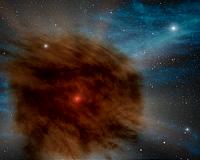 |
Toronto, Canada (SPX) Dec 06, 2010 A team of physicists from the University of Toronto and Rutgers University have mimicked the explosion of a supernova in miniature. A supernova is an exploding star. In a certain type of supernova, the detonation starts with a flame ball buried deep inside a white dwarf. The flame ball is much lighter than its surroundings, so it rises rapidly making a plume topped with an accelerating smoke ring. "We created a smaller version of this process by triggering a special chemical reaction in a closed container that generates similar plumes and vortex rings," says Stephen Morris, a University of Toronto physics professor. Autocatalytic chemical reactions release heat and change the composition of a solution, which can create buoyancy forces that can stir the liquid, leading to more reaction and a runaway explosive process. "A supernova is a dramatic example of this kind of self-sustaining explosion in which gravity and buoyancy forces are important effects. We wanted to see what the liquid motion would look like in such a self-stirred chemical reaction," says Michael Rogers, who led the experiment as part of his PhD research, under the supervision of Morris. "It is extremely difficult to observe the inside of a real exploding star light years away so this experiment is an important window into the complex fluid motions that accompany such an event," Morris explains. "The study of such explosions in stars is crucial to understanding the size and evolution of the universe." The research will appear in Physics Review E in the next few weeks. In addition to Morris and Rogers, the research team included Abdelfattah Zebib from Rutgers. The work was funded by the Natural Sciences and Engineering Research Council of Canada. See the video: Convecting chemical plumes
Share This Article With Planet Earth
Related Links the missing link Stellar Chemistry, The Universe And All Within It
 Giant Supernova Smothered By Its Own Dust
Giant Supernova Smothered By Its Own DustColumbus OH (SPX) Oct 20, 2010 A giant star in a faraway galaxy recently ended its life with a dust-shrouded whimper instead of the more typical bang. Ohio State University researchers suspect that this odd event - the first one of its kind ever viewed by astronomers - was more common early in the universe. It also hints at what we would see if the brightest star system in our galaxy became a supernova. In a paper ... read more |
|
| The content herein, unless otherwise known to be public domain, are Copyright 1995-2010 - SpaceDaily. AFP and UPI Wire Stories are copyright Agence France-Presse and United Press International. ESA Portal Reports are copyright European Space Agency. All NASA sourced material is public domain. Additional copyrights may apply in whole or part to other bona fide parties. Advertising does not imply endorsement,agreement or approval of any opinions, statements or information provided by SpaceDaily on any Web page published or hosted by SpaceDaily. Privacy Statement |